Honor Award
South Grand Boulevard
"Great Streets Initiative"
St. Louis
Design Workshop, Inc., Aspen
Client: East-West Gateway Council of Governments
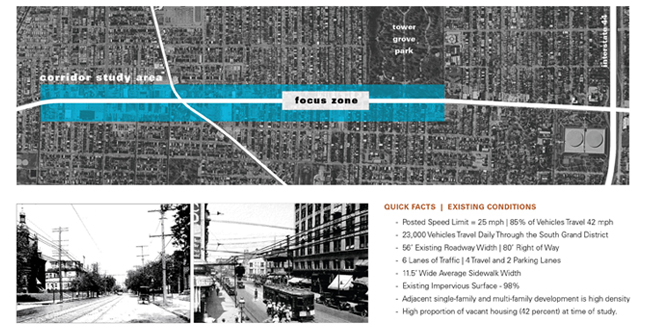 Close Me!
Close Me!Context and Existing Conditions. The "Great Streets Initiative" seeks to improve the environmental quality for the streetscape and its safety, walkability and aesthetics, while strengthening the district's economic opportunities, community amenities and livability and setting new standards for sustainability, accessibility and public engagement.
Download Hi-Res ImageImage: Design Workshop, Inc.
Image 1 of 16
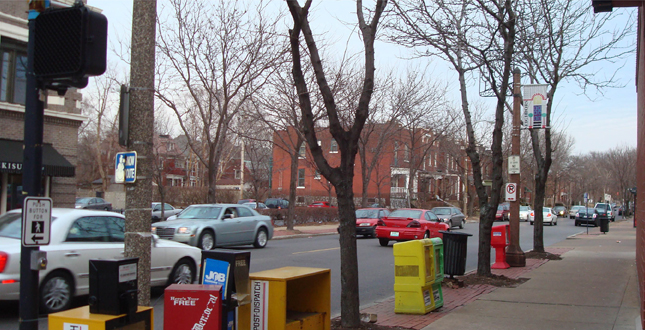 Close Me!
Close Me!Current Conditions: The design team had less than four months to gain community approval of a master plan and complete construction documents in order to prevent losing allocated funding for the project.
Download Hi-Res ImageImage: Design Workshop, Inc.
Image 2 of 16
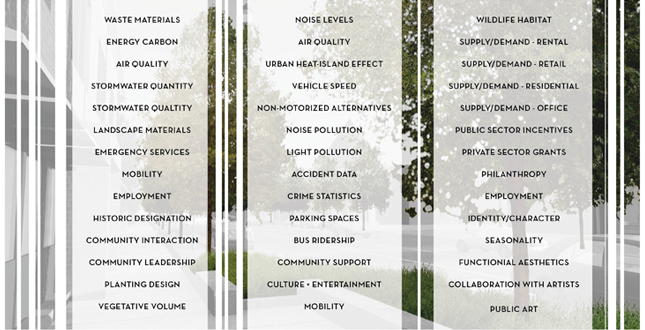 Close Me!
Close Me!How does one achieve success? The landscape architect challenged the notion of recognizing when, and if, a project is considered successful. As a result, the proposed master plan achieves the most extensive use of project metrics by an American landscape architecture project known to date.
Download Hi-Res ImageImage: Design Workshop, Inc.
Image 3 of 16
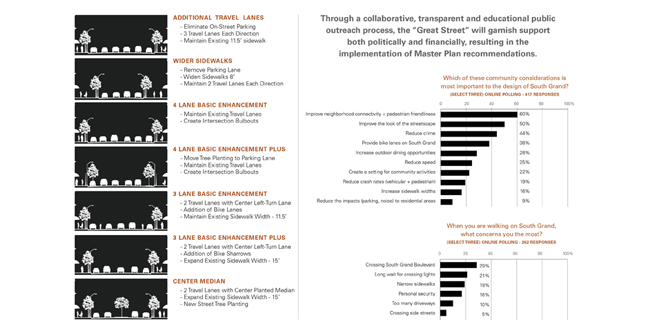 Close Me!
Close Me!Understanding Your Community. An extensive public process utilized keypad polling, online surveys and special-interest group meetings to allow, the public to define selection criteria. The public's engagement revealed the three most significant issues facing South Grand: Pedestrian Friendliness, Economic Development and Visual Appearance.
Download Hi-Res ImageImage: Design Workshop, Inc.
Image 4 of 16
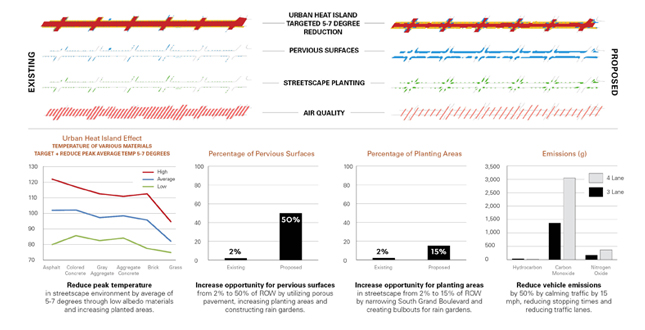 Close Me!
Close Me!The Environmental Construct. Through a multi-strategy approach, the team achieved a 48 percent increase of pervious surfaces — from 2 percent to 50 percent. The strategies can be easily transferable to other parts of the city, providing solutions to address the combined sewer problems.
Download Hi-Res ImageImage: Design Workshop, Inc.
Image 5 of 16
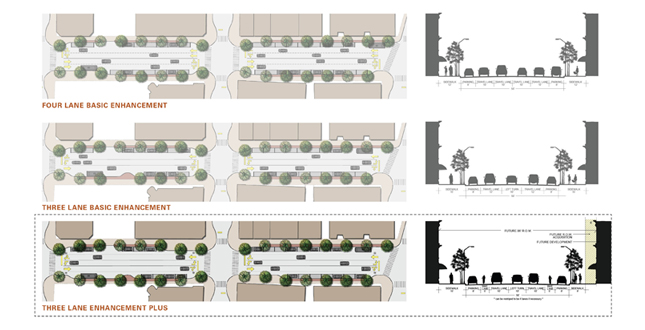 Close Me!
Close Me!Achieving "The Road" to Success. From the three shortlisted alternatives, the community supported to reduce South Grand to a three-lane configuration. To ensure traffic flows remained functional prior to the commitment of significant public funding, the landscape architect recommended a one-month pilot test.
Download Hi-Res ImageImage: Design Workshop, Inc.
Image 6 of 16
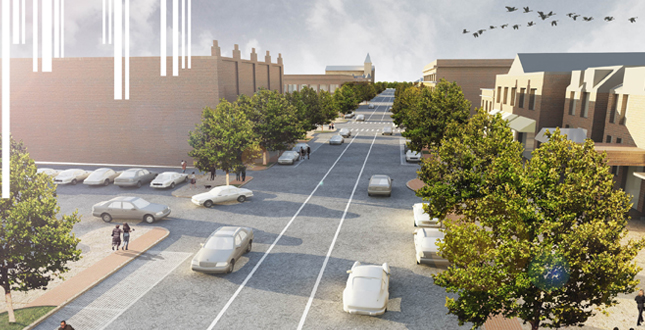 Close Me!
Close Me!Garnering Community Support. A "bioblitz" determined the presence of urban wildlife prior to development. A dramatic 20 percent increase in tree canopy will not only help to reduce heat island and increase storm water infiltration, but will also foster the presence of wildlife.
Download Hi-Res ImageImage: Design Workshop, Inc.
Image 7 of 16
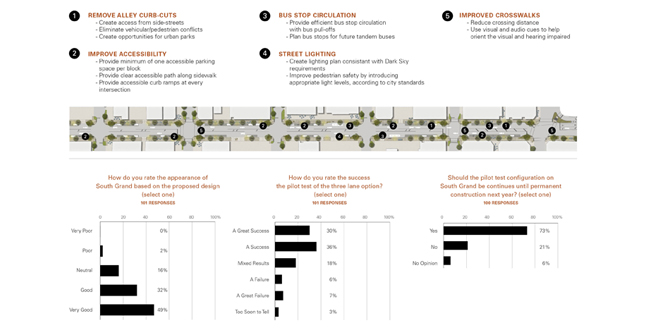 Close Me!
Close Me!A Transferable Design Strategy. South Grand creates an implementable design that addresses the key concerns of the community, provides economic and social benefits to the district, demonstrates cutting-edge approaches to sustainability and improves the long-term livability and vibrancy of the business district.
Download Hi-Res ImageImage: Design Workshop, Inc.
Image 8 of 16
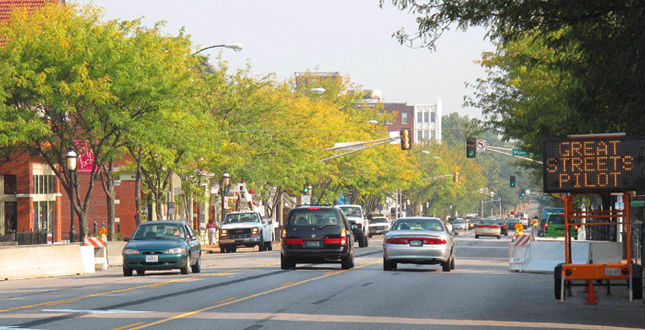 Close Me!
Close Me!Pilot Test: If You Build It, Will They Even Come? A real-life mockup of the proposed solution reduced travel lanes from four to three, lowered traffic speeds and improved pedestrian safety. Auto accidents were reduced by three fourths with substantial financial savings to the city and its citizens.
Download Hi-Res ImageImage: Design Workshop, Inc.
Image 9 of 16
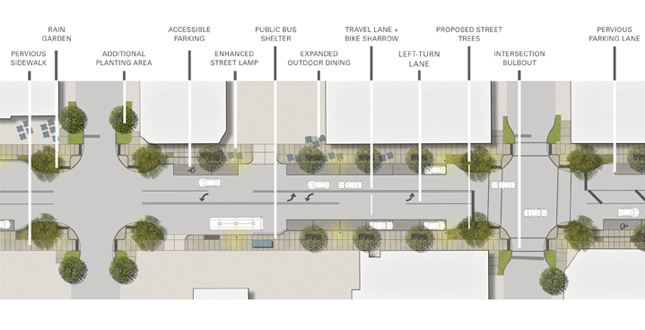 Close Me!
Close Me!A Complete Street. South Grand set new standards for sustainability. ADA accessibility and public engagement applied to future projects city-wide. The public engagement techniques provide a valuable example of how to advance designs into implementation through stakeholder buy-in under an extremely compressed schedule.
Download Hi-Res ImageImage: Design Workshop, Inc.
Image 10 of 16
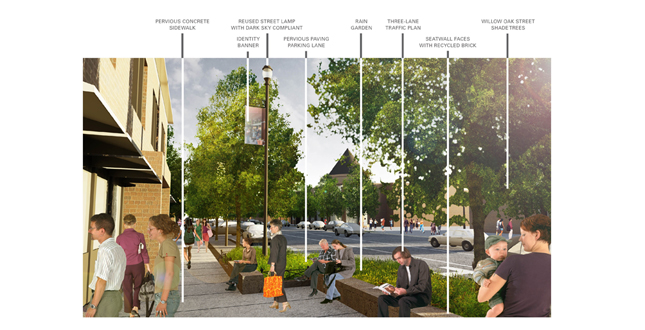 Close Me!
Close Me!A Revitalized Streetscape Rooted in Environmental and Community. A 36 percent increase in sidewalk width provided room for outdoor dining, accessibility and healthy street trees. All demolished and removed materials will be reused in other city-wide construction projects. All new materials will be composed of recycled, local materials.
Download Hi-Res ImageImage: Design Workshop, Inc.
Image 11 of 16
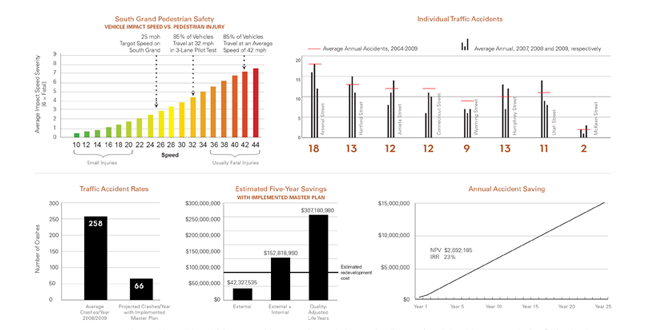 Close Me!
Close Me!Addressing Public Safety. The landscape architects addressed the public’s concern of street crossings, reducing crossing distances from 56' to 37' — over 1/3 reduction. During the pilot test, traffic speeds were reduced over 10 mph, lowering from the fatal threshold of 36-44 mph.
Download Hi-Res ImageImage: Design Workshop, Inc.
Image 12 of 16
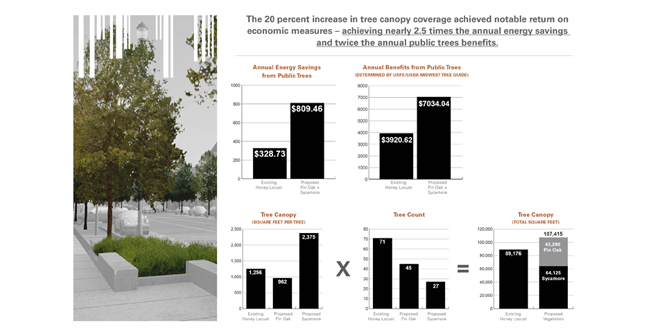 Close Me!
Close Me!What Supplemental Effects Do Street Trees Achieve? Existing tree openings — 16 square feet in area — were increased more than six times to current arborist recommendations of 100 square feet and 1000 cubic feet of planting soil per tree, fostering successful tree growth and increasing human comfort.
Download Hi-Res ImageImage: Design Workshop, Inc.
Image 13 of 16
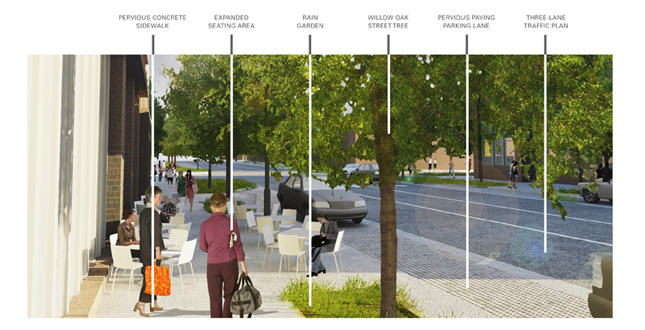 Close Me!
Close Me!A Livable Setting for its Community. As this portion of South Grand is currently the major ethnic neighborhood district in the St. Louis region, an emphasis was placed upon substantially increasing the amount of space available for seating and outdoor dining through the district.
Download Hi-Res ImageImage: Design Workshop, Inc.
Image 14 of 16
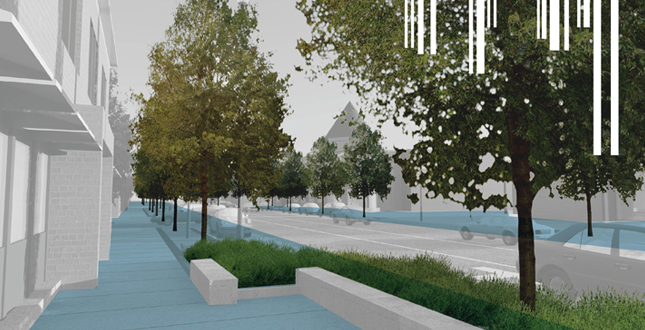 Close Me!
Close Me!Stormwater Management. Because St. Louis is under court order to improve its combined sewer system, implementing green stormwater techniques was a design criterion. The project demonstrates the first use of porous paving materials and the first constructed rain gardens in the region.
Download Hi-Res ImageImage: Design Workshop, Inc.
Image 15 of 16
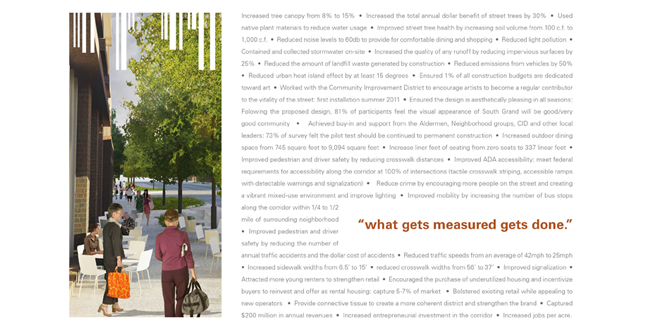 Close Me!
Close Me!Our Proof of Success. The Master Plan builds upon the strengths of the street, transforming the district from a major thru-street into a revitalized public destination. Although held to an expedited schedule, the landscape architect's diligence achieved measurable results which identify the project's success.
Download Hi-Res ImageImage: Design Workshop, Inc.
Image 16 of 16
Project Statement
With the philosophy of "what gets measured gets done," the landscape architect achieved a transparent public process driven by rigorous research and measurement, developing over forty metrics including pedestrian mobility, employment, urban wildlife and financial rate-of-return to assess the success of the design. The existing streetscape — 98 percent impervious with traffic speeds exceeding life-threatening fatal levels — was reconstructed into a livable. Challenging past design assumptions, the exercise redefines the relationship between transportation and community.
Project Narrative
Paving the Foundation
—2011 Professional Awards Jury
South Grand Boulevard and its bordering neighborhoods are known as the "international community" of St. Louis because of the diverse population and wealth of ethnic restaurants. It is a racially diverse area where new immigrants are assimilated into the city. As the city suburbanized over the last 50 years, traffic volumes have increased to nearly 25,000 vehicles per day with average speeds of 42 miles per hour (exceeding posted speed limits by 17mph). Increased traffic volumes and speeds have resulted in noise levels ranging from 64-74 decibels, peaking above 75dB with trucks, motorcycles and buses, which is above the noise level typically required for residential sound walls. Averaging 80 accidents per year, the corridor is an undesirable environment for retail stores and restaurants, causing many people to feel unsafe crossing South Grand or walking its sidewalks at night. Because of its close proximity to the Missouri Schools for the Deaf and the Blind, the corridor presents a dangerous interface for human/vehicular interaction.
Of the existing streetscape, 98 percent is impervious, leaving the only vegetative relief in the form of unhealthy and stunted street trees by small 3’x3’ tree openings. Similar to many Midwest cities, St. Louis is under federal court order to address its combined sewer problem, requiring the team to create innovative green solutions essential to reducing storm water loading on the existing system at moderate costs and in a manner that provides additional environmental benefits. Many neighborhoods through St. Louis and other American cities share South Grand’s current conditions, with limited funds available to address their issues. The design solution offers a model for other cities facing similar challenges.
The "Great Streets Initiative"
In 2009, South Grand Boulevard was selected as one of four "Great Streets Initiative" pilot projects in the St. Louis region. "Great Streets" are intended to reflect the character of the neighborhoods through which they pass. The desired relationship between the street and its adjacent buildings is organic, conducive to walking, and inviting to people. "Great Streets" facilitate the interaction of people and the promotion of commerce. They serve as destinations, not just transportation channels and create complete streets of transit, walkability, recreation, sustainability and safety. Envisioned to create a sustainable setting for smart growth, the plan must foster support among political and community members and serve as a transferable model project for future redevelopment in the St. Louis region.
Process
Hired in mid-August, 2009, the landscape architects were charged to gain community approval of a master plan and complete construction documents by December 1 of that same year. In order to meet the short schedule, the landscape architect led a comprehensive design process, placing considerable focus on fully understanding the project history, existing conditions and key issues and continually involving the community to garner their vision for the future of South Grand. The team presented nine possible cross-sections that could potentially gain the support of the community. Through key-pad and online polling, the public ranked the options according to how each could best address their concerns, reducing the initial nine scenarios to three for final consideration.
Challenging Traditional Processes
The design team developed over 40 metrics against which every design decision was tested throughout the project, ensuring that the final result would align with the community’s needs and the project goals and objectives. The design metrics were based on information collected on Storm water Quality; Vegetative Volume; Noise Levels; Air Quality; Urban Heat-Island Effect; Vehicle Speed; Accident Data; Crime Statistics; Light Levels; Public Art; Retail, Office and Residential Supply and Demand; Employment; Community Support; and Mobility, among others. Metrics served as the tool for educating the public on existing conditions, goals and trade-offs. Although selected for the ASLA Sustainable Sites pilot program, the project budget did not allow participation. Nonetheless, the South Grand plan was scored against that system and provides the most extensive use of project metrics by an American landscape architecture project known to date. The South Ground master plan goes beyond the environmental objectives of Sustainable Sites and LEED to consider issues of economics, community and aesthetics in a measurable way.
"The Road" to Success
From the three shortlisted alternatives, the community selected a preferred alternative which reduces South Grand from a four-lane to a three-lane configuration. To ensure traffic flows remained functional prior to the commitment of significant public funding, the landscape architect recommended a one-month pilot test. The roadway was restriped, make-shift bulb outs were created and signal timing was adjusted according to traffic-modeling studies. The test demonstrated that the preferred plan would lower traffic speeds from an average of 45 to 32 miles per hour. As a result, noise levels dropped eight decibels, to a range suitable for conversation. One month after implementation, polling showed 73 percent of the public believed the pilot test was a success and should continue to construction.
The Environmental Construct
Through a multi-strategy approach, the design team achieved a 48 percent increase of pervious surfaces — from 2 percent to 50 percent — throughout the corridor. The project demonstrates the first use of porous paving materials and among the first constructed rain gardens in the St. Louis region. A 36 percent increase in sidewalk width provided room for outdoor dining, accessibility and healthy street trees. All demolished and removed materials will be reused were recycled for other construction projects. Wherever possible, existing site furniture was reused. New materials will be composed of recycled, local materials. The strategies can be easily replicated in other parts of the city, using simple, economical design and providing model storm water solutions to address the combined sewer problems. Collaborating with dark-sky experts, the landscape architect proposed a compliant fixture which utilizes the existing post, thus saving additional money, the first utilized for St. Louis public streets.
The landscape architect conducted a "bioblitz" to determine the amount of urban wildlife — birds, squirrels, butterflies and insects — present prior to development. Introduced native species provide a 13 percent increase in planted over the existing condition and a 20 percent increase in tree canopy in the new plan will not only help to reduce urban heat island and increase storm-water infiltration but also increase the presence of wildlife along the corridor. In order to insure the project’s value as a demonstration project, aesthetics were based upon inexpensive, durable materials used in the most-efficient manner possible rather than upon precious materials which the city could not afford to utilize throughout the city.
Garnering Community Support
The project has set new standards for local sustainability, ADA accessibility and public engagement applied to future projects city-wide. The public engagement techniques provide a valuable example of how to quickly and efficiently advance a design from conception to implementation with strong consensus and stakeholder buy-in under an extremely compressed schedule. The metrics provide a basis from which to measure success, as well as serve as a tool for education and clear decision making. Based upon the success of the South Grand effort, a new standard of public engagement has been set for the region. Local neighborhoods will be emboldened to undertake their own road diets, and the City of St. Louis can move forward to confidently implement new standards for sustainable design.
Design within Reach: Economics
Although the majority of the effort was based upon design and implementation, the master plan also included an economic analysis of the existing market conditions. The team worked with the Capital Improvement District to implement improved marketing and management techniques for the district. As this portion of South Grand is currently the major ethnic neighborhood district in the St. Louis region, an emphasis was placed upon substantially increasing the amount of space available for seating and outdoor dining. The closing of some alleys will provide additional dining space for adjacent restaurants and move trash storage and pickup out of public view. Even though space for improved transit stops was made available, the total quantity of on-street parking was increased through more efficient design. Smart parking meters will provide greater convenience for shoppers and diners and improve turnover during peak shopping and dining periods. Reduced noise and improved safety, including a 74 percent projected drop in accident rates, will enhance the shopping and dining experience. Over time new mixed-use buildings with defined "build to" lines and active ground floor uses will fill in the current gaps along the shopping corridor. Residents in upper floor housing units will enliven the streetscape. A fiscal return on the city’s investment is projected to provide capital projected to exceed 23 percent based upon reduced crime prevention and accident costs and increased sales tax.
Transferability and Implementation
In addition, a Master Plan book was developed to lay the foundation for future improvement along the larger corridor. Over time, this will allow the design scheme to continue an additional seven blocks. The master plan will provide a proven model for future "Great Streets Initiative" efforts and redevelopment projects. Although the proposed streetscape and economic development strategies are unique to the South Grand district, the approach, process and metrics can continually be applied. A total of $3.1 million has been set aside to construct the initial eight-block segment of the South Grand improvements. The project is currently under construction.
Project Resources
Land Planner & Landscape Architect: Design Workshop, Inc.
Landscape Architect:
Kurt Culbertson, FASLA; Lead Designer: Paul Squadrito
Transportation Engineers: Nelson Nygaard
Transportation Engineers: TND Engineering
Civil Engineer: Horner and Shifrin, Inc.
Market Analysis: RCLCO
Public Engagement: Hudson and Associates, LLC
Irrigation Design: Austin Tao and Associates
Austin Tao, FASLA
Art Planning: Via Partnership, LLP
Cost Estimating: Kwame Building Group
Site Surveying: Kowelman Engineering, Inc.
Stormwater Expert: Bruce Ferguson
Urban Tree Expert: Urban Trees + Soils






